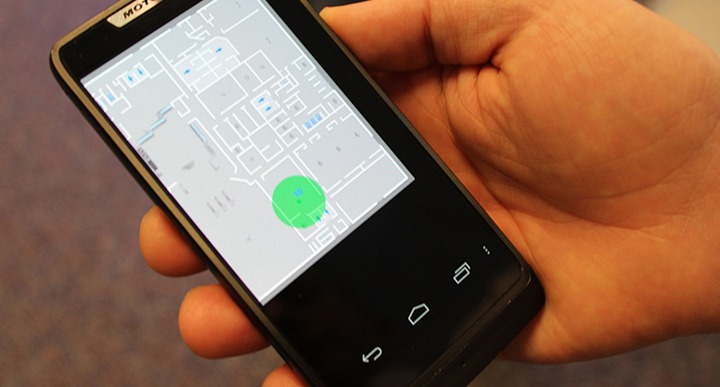Estimating one’s own position has always been a central problem in human history. While the need for obtaining the physical position of humans and objects has been an old request for society, it becomes apparent that in the future, the importance of localisation will ever grow. New breakthroughs in sensors, electronics, and information technology, enable ever new applications that demand real-time accurate location information at low cost. Furthermore, many of these applications are situated indoors, as human and machines tend to spend more and more time of their days within buildings.
The fundamental problem of indoor positioning
Besides traditional applications, indoor localisation has experienced additional efforts in recent years with the appearance of ubiquitous computing. In various scenarios, objects and humans must be located or tracked, e.g. in an industrial or medical environment. Additionally, people localisation enables a large number of applications and services. Customers and employees can be observed, intruders detected, elderly people supported, and patients tracked. In public places like subway stations or airport terminals, safety concerns can be addressed by an emergency guidance system. A similar situation may occur in a hotel or in a shopping centre. A guidance system fed with position information of humans may work more efficiently than a blind one. Finally, besides distributed sensing, indoor positioning allows for context-aware information to customers and may improve network efficiency and low power demands.

This article aims to expose current indoor positioning systems based upon existing wireless infrastructure. The deployment of WiFi networks which rely on IEEE (Institute of Electrical and Electronic Engineers) 802.11 standard has experienced an overwhelming success in the last decade, powered by the explosion of high-density networks with users demanding instant, high-quality, multimedia content. It supposes a fast, reliable, and cheap way of providing Internet service to indoor scenarios. Furthermore, it is expected that the number of WiFi connected devices shall grow exponentially in the next decade, as Internet of Things (IoT) penetrates into our society.
“It is expected that the number of WiFi connected devices shall grow exponentially in the next decade”
By installing wireless positioning technology on already deployed infrastructures, the operational cost reduces to the minimum. Thus, network administrators are able to access to a vast variety of information from users within their buildings, obtaining confident analytics and reliable accuracy, while preserving the privacy. However, there are two paradigms for indoor positioning, depending on which devices of the RAN (Radio Access Network) gather and processes the information:
- Client side: The client device (also known as STA) computes its own position by using specific hardware of software, like the built-in GPS (Global Positioning System) chip, inertial sensors, installed apps, … This method achieves a high degree of accuracy at the expense of relying on user’s will to be located. The main disadvantage is that the client may decide (and usually does) not to provide this succulent information to the network.
- Network side: The clients do not need to modify their software, as location process is entirely done by the devices provided by the RAN. The process is entirely transparent to the people using the wireless network. This has the huge advantage of gathering fresh location analytics from anonymous users without disturbing them, modifying their smartphones, or requesting for odd installation of apps. The location process is fully done by exploiting existing information shared between STAs and APs (Access Points), which are the nodes that serve as an interface between client devices and the core of the network. Nowadays, it is still an open problem and there are several state-of-the-art proposals for improved accuracy and robustness of the location process.
Gathering the relevant information
As the 802.11 standard evolves, it is complemented with amendments which aim to provide novel management mechanisms. We refer the reader to the documents describing 802.11v, 802.11r and 802.11k, among others. They present smart mechanisms for a simple interchange of advanced management and control frames between network nodes. However, this article advocates on presenting feasible solutions for the indoor location problem, even when the devices on the network only support standard WiFi amendments, like 802.11n or 802.11ac standards. This is usually constrained by old STAs, or even by devices which have those advanced features inhibited.

The technological challenge is to obtain the relevant information and to apply it to an estimation algorithm. There are many approaches to the problem, but all are generally based on exploiting the geometry of the network infrastructure. If we know the positions of the APs with respect to a fixed coordinate system, it is sufficient to find the distances from some of them to the desired STA. However, estimating distances in a wireless environment is not straightforward. In fact, there are several electromagnetic phenomena like dispersion, multipath, interferences, fast and slow fading, and things even worse. In addition, the indoor location problem inherently presents a moving and changing environment, where people may be wandering, and furniture and walls may not be fixed.
“If we know the positions of the APs with respect to a fixed coordinate system, it is sufficient to find the distances from some of them to the desired STA”
To overcome these problems, we present here some of the most successful methods for wireless indoor positioning. We have focused on real-world, feasible solutions, which rely on user transparency, and zero changes on the deployment of the WiFi infrastructure. The following four families of methods are arranged from the easiest to the most difficult one:
- Indoor location based on Signal Strength (SS): the most direct way of estimating the distance from an electromagnetic source to a receiver is to estimate it from a simple theoretical model based on the RSSI (Received Signal Strength Indicator). However, the power received on a specific 802.11 channel is a coarse value and vary more than we would like to, due to multipath and fading effects. For these reasons, it is easy to implement but it attains a humble accuracy, in the order of 5-7 meters.
- Indoor positioning based on Time of Flight (ToF): as radio waves propagate at light speed, one can measure the distance between two network nodes by computing the time elapsed between the timestamps associated with sending data and receiving the corresponding ACK (acknowledgement). The problem is that current WiFi chips suffer when they are requested for timestamps in the order of nanoseconds. In addition, there is an intrinsic time bias that corresponds to the frame processing at the STA, which highly depends on the electronics of the processor. Nevertheless, this simple method is able to locate devices in a range of 3-5 meters.
- Indoor positioning based on Difference Time of Arrival (DToA): the main drawback for computing the time of flight of a data-ACK pair is the uncertainty on the processing time of the received frame at the client device. However, this frame processing may be supposed to be constant, so it is more precise to compute the difference of arrival times between two or more APs to the same STA. This defines a series of hyperbolas that intersect at the desired location. This method requires for finer time resolution but achieves localisation errors within 1-3m. Moreover, it is insensitive to multipath, walls and moving objects, which is the main drawback of power-oriented methods like the ones based on RSSI.
- Indoor positioning based on Channel State Information (CSI): the CSI is a complex-valued matrix available in some modern WiFi drivers, which reveals the nature of the propagation path between the transmitter and each one of the receiver antennas. Of course, the more antennas we have in MIMO (Multiple Input-Multiple Output) systems, the better. This has been recently used to estimate the direction of arrival of the electromagnetic energy (which is known as receiver beamforming), among other promising uses. This opens the door to novel indoor location protocols that attain sub-meter accuracy.

It should be noted that we have deliberately omitted techniques involving complex and expensive processes like fingerprinting, where one has to create a previous database of all the spots and their corresponding radio propagation features, by manually collecting the data. In addition, these fancy methods do not work when there are obstacles which change their positions, like people or furniture.
In our next articles, we will delve into the details of these promising techniques, as well as show how Galgus combines them to solve the WiFi-based indoor location problem.
“Galgus is boosting wireless performance in all possible WiFi scenarios thanks to its patented Cognitive Hotspot Technology (CHT). Our Research team is focusing on developing novel indoor localisation technology, which together with the benefits of CHT will make your WiFi network perform better than ever, even in the most demanding situations.”









